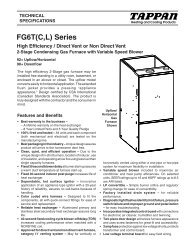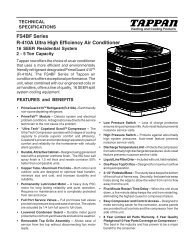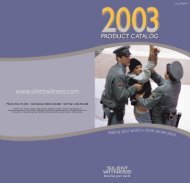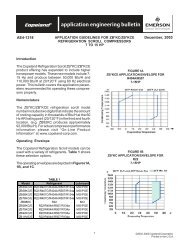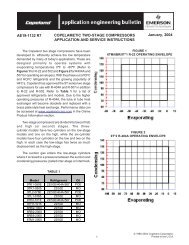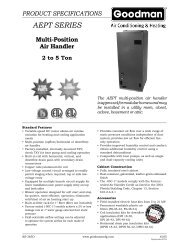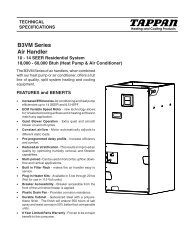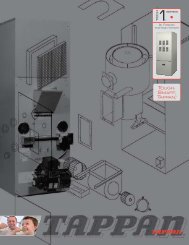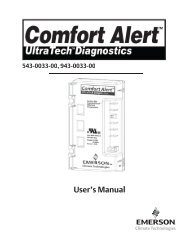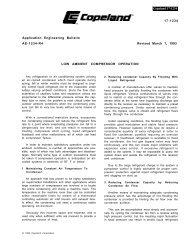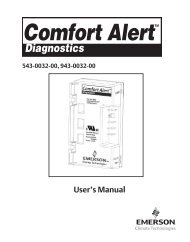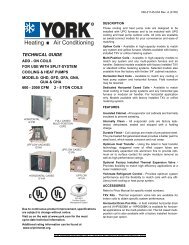Bristol Scroll Compressors - Desco Energy
Bristol Scroll Compressors - Desco Energy
Bristol Scroll Compressors - Desco Energy
- No tags were found...
You also want an ePaper? Increase the reach of your titles
YUMPU automatically turns print PDFs into web optimized ePapers that Google loves.
.WARNING: Never use oxygen to pressurize a refrigeration or air conditioning system.Oxygen can explode on contact with oil and could cause personal injury. When using highpressure gas such as nitrogen or CO 2 for this purpose, be sure to use a regulator that cancontrol the pressure down to 1 or 2 psig.The following instructions are general but include major points of consideration that will ensure proper installation andprotect you from possible personal injury. Please use this as a checklist, taking each item in its order before proceedingto the next. If more information is required, please call <strong>Bristol</strong> <strong>Compressors</strong> Service Department.1. VERIFY PROPER APPLICATION. Verify that the compressor being replaced and the <strong>Bristol</strong> compressorhave a like capacity for the refrigerant being used and that the voltage and frequency characteristics arethe same. Consult your wholesaler if you have any questions about proper compressor application.WARNING:To avoid electrical shock, power to the compressor should remain off duringperformance of Steps 2 thru 9.2. DETERMINE CAUSE OF INITIAL FAILURE. Double check system and associated controls to make surecompressor replacement is necessary. In order to prevent a second failure, the cause of the originalfailure must be determined. Identify the cause and make the necessary repairs. This may requirethorough system monitoring after the replacement is installed and running.A. BEFORE REMOVING THE FAULTY COMPRESSOR: Remove refrigerant charge using properrecovery procedures. <strong>Bristol</strong> scrolls have no process tubes. Access to the system is normallyachieved at the suction or discharge service valve or the access fittings in the low and/or high side ofthe system. If the system does not have access fittings, they should be installed. Because of the<strong>Bristol</strong> scrolls’ internal sealing ability, refrigerant must be recovered through both the high and lowside to avoid trapping refrigerant. Failure to do so could result in a hazardous condition if a torch isused to disconnect lines. Call 1-800-441-9450 for the name of the nearest Dupont authorizeddistributor, or 1-800-631-8138 for Genetron Representative or 1-800-ASK-KLEA (ICI) for informationon their refrigerant reclaim programs.B. Remove the electrical leads from the compressor. Note the terminal to which each wire is connected.C. During the next operation, the access ports should be open so that pressure does not build up in thesystem. If space permits, cut both the suction and discharge lines loose as close to compressor aspossible with tubing cutter. If sweating them loose is necessary, use a high temperature torch and beprepared to extinguish any remaining oil or refrigerant that may possibly ignite when lines aredisconnected.D. To assure excessive oil does not remain in the system, measure oil in failed compressor.Oil Charge Levels. <strong>Bristol</strong> <strong>Scroll</strong> compressors are charged with oil at the factory to the levelspecified on the code plate. For compressors using Refrigerant 22, the oil used is Zerol 150 with 3%Syn-O-Ad. If additional oil charge is added for in-service conditions, only Zerol 150 with Syn-O-Adshould be used. Oil levels can vary with different models and manufacturers. Refer to the individualmodel specification or consult your wholesaler to obtain this information.NOTE: If oil level is low, flush excess from system.CAUTION: The compressor may contain harmful acids ⎯ be sure to handle with extreme care usingproper protection equipment. After confirming oil charge level, return oil to the compressor. Thesuction and discharge copper tube fittings should be securely plugged or brazed closed. This isneeded to prevent further contamination of the compressor and to prevent spillage from thecompressor.3. MOUNT THE NEW COMPRESSOR. Do not remove dust cover or rubber shipping plugs until all otherconnections have been completed (i.e., filters installed and all tubing changes made ⎯ see steps 4 and 5).Compressor should not be open to the atmosphere for more than 15 minutes. Be sure to use the newPage 2



